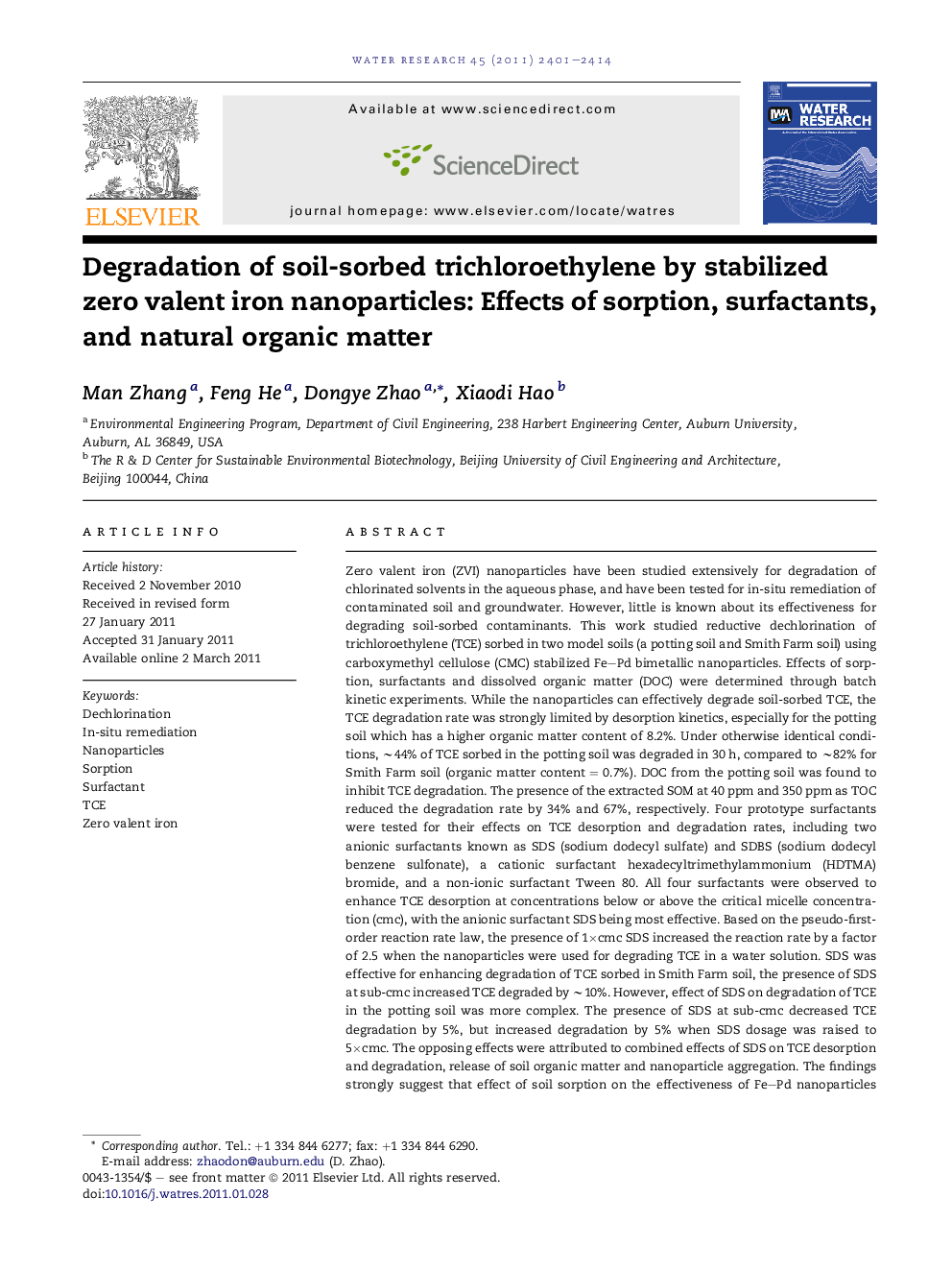| کد مقاله | کد نشریه | سال انتشار | مقاله انگلیسی | نسخه تمام متن |
|---|---|---|---|---|
| 4484198 | 1316912 | 2011 | 14 صفحه PDF | دانلود رایگان |

Zero valent iron (ZVI) nanoparticles have been studied extensively for degradation of chlorinated solvents in the aqueous phase, and have been tested for in-situ remediation of contaminated soil and groundwater. However, little is known about its effectiveness for degrading soil-sorbed contaminants. This work studied reductive dechlorination of trichloroethylene (TCE) sorbed in two model soils (a potting soil and Smith Farm soil) using carboxymethyl cellulose (CMC) stabilized Fe–Pd bimetallic nanoparticles. Effects of sorption, surfactants and dissolved organic matter (DOC) were determined through batch kinetic experiments. While the nanoparticles can effectively degrade soil-sorbed TCE, the TCE degradation rate was strongly limited by desorption kinetics, especially for the potting soil which has a higher organic matter content of 8.2%. Under otherwise identical conditions, ∼44% of TCE sorbed in the potting soil was degraded in 30 h, compared to ∼82% for Smith Farm soil (organic matter content = 0.7%). DOC from the potting soil was found to inhibit TCE degradation. The presence of the extracted SOM at 40 ppm and 350 ppm as TOC reduced the degradation rate by 34% and 67%, respectively. Four prototype surfactants were tested for their effects on TCE desorption and degradation rates, including two anionic surfactants known as SDS (sodium dodecyl sulfate) and SDBS (sodium dodecyl benzene sulfonate), a cationic surfactant hexadecyltrimethylammonium (HDTMA) bromide, and a non-ionic surfactant Tween 80. All four surfactants were observed to enhance TCE desorption at concentrations below or above the critical micelle concentration (cmc), with the anionic surfactant SDS being most effective. Based on the pseudo-first-order reaction rate law, the presence of 1×cmc SDS increased the reaction rate by a factor of 2.5 when the nanoparticles were used for degrading TCE in a water solution. SDS was effective for enhancing degradation of TCE sorbed in Smith Farm soil, the presence of SDS at sub-cmc increased TCE degraded by ∼10%. However, effect of SDS on degradation of TCE in the potting soil was more complex. The presence of SDS at sub-cmc decreased TCE degradation by 5%, but increased degradation by 5% when SDS dosage was raised to 5×cmc. The opposing effects were attributed to combined effects of SDS on TCE desorption and degradation, release of soil organic matter and nanoparticle aggregation. The findings strongly suggest that effect of soil sorption on the effectiveness of Fe–Pd nanoparticles must be taken into account in process design, and soil organic content plays an important role in the overall degradation rate and in the effectiveness of surfactant uses.
► CMC-stabilized Fe-Pd nanoparticles can effectively degrade soil-sorbed TCE.
► TCE desorption kinetics from soils can limit degradation rate.
► DOM can inhibit dechlorination by ZVI nanoparticels.
► SDS can enhance TCE desorption and TCE degradation by Fe-Pd nanoparticles.
► CMC-stabilized Fe-Pd nanoparticles can be adsorbed to soil matrix.
Journal: Water Research - Volume 45, Issue 7, March 2011, Pages 2401–2414